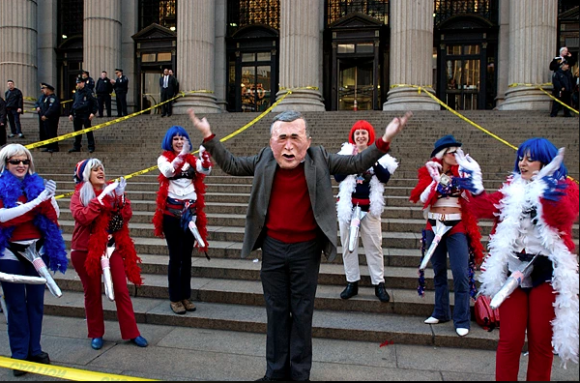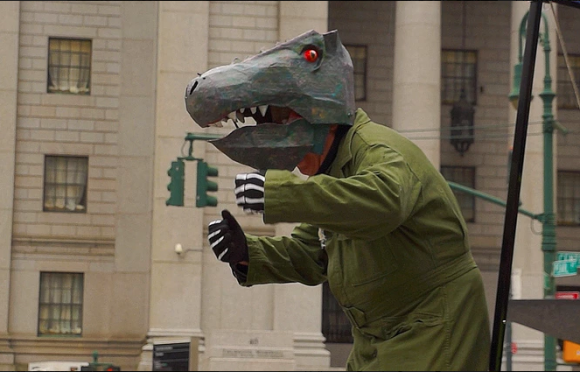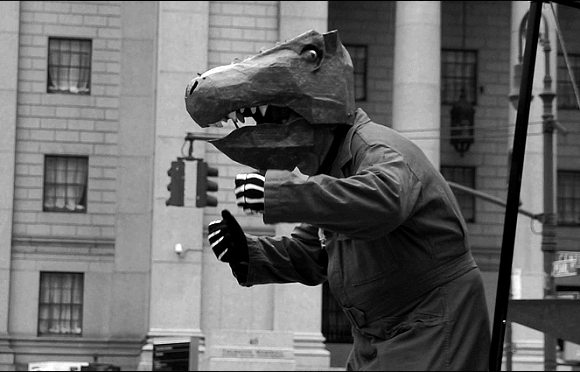
Images operate the same way that memories do; images have this deep-seated attachment to your mind and I like to think that the images ingrain themselves into people…It really makes them want to stop for a minute and read the article. And hopefully it’s not a terribly biased article. And hopefully the image, in itself, makes people see something in a new way.
Elliot Crown is a performer, puppet maker, circus clown, and activist based in New York City. He creates caricatures of political leaders, Wall Street executives, and politically-relevant concepts in order to capture media attention and enliven protests. Crown uses media attention (or lack thereof) as one of his primary metrics of success or failure, and believes that images can help to advance social movements through their humor, shock value, and relatability.
SJH: You do a lot of performances with costumes, puppets, and masks. Can you tell me about how you came to that creative practice?
EC: I was performing in the 2000s with the Missile Dick Chicks, who were outrageous – they were a radical women’s troup that wore red, white, and blue, and they sang pro-war songs and talked in phony Texas accents. They were from Midland, Texas where Bush is from, and they pretended that they were high on Oxycontin and martinis. So it was a singing and dancing group and I played “Dubya” with a brilliant papier-mâché helmet-mask. They’d go to rallies and say things like, “You dirty hippies don’t understand! George Bush is a genius! We just gotta kick some ass and get that gas!” They were monsters! It was a funny slam on the patriarchy, and our big song was “Shop – in the name of war / You need a whole lot more / Don’t think about it.” And all the while they were wearing two-foot long papier-mâché strap-on penises that looked like cruise missiles. Totally insane!
We’d perform in Times Square almost weekly. I was in the Dubya mask, so I could watch people’s reactions and they couldn’t see me. People would come up and their jaws would drop and not know what they fuck we were doing. A bunch of women with silver penises?! And then, they’d listen. And that was the beauty of it – they just cracked their consciousness completely to shreds and it made the people go, “What is this?” And then the songs were very funny and instructive. So, that was a good, very theatrical thing.

Pictured above: Elliot Crown as “Dubya” and the Missile Dick Chicks in 2007
With the Missile Dick Chicks, I wore this brilliant mask, this Bush caricature made by Hadine Anderson, a gifted artist and activist. I wore it all through the 2000s, at the RNC and stage shows, and Bowery Project, I mean, we were invited everywhere. We did a march down Broadway once, and the police microphoned, “Ladies and Gentlemen, here’s the Missile Dick Chicks!” The police announced us! And there’s a documentary . I’m a performer, actor, and circus clown, and all of that came together. And then after that, I don’t know, I just started making political masks that I could use for my own stuff.
SJH: What about a performance where you made your own masks?
EC: The first one that I made was half Statue of Liberty, half skull. I wore that in the Halloween parade two years before Occupy Wall Street, and that Lady Liberty dragged a guillotine made out of papier-mâché. I had six friends of mine dress up with black hoods on as if they’ve had their heads chopped off. One had a sign that said, “Wall Street Executive,” one had a sign that said, “Fox News Executive,” another was, “Healthcare Executive,” and one had a sign that said, “The Wrong Guy.” And nobody got it! People just stared, the cops didn’t like it, they weren’t sure what it was. Sometimes they just don’t get it.
Nonetheless, I was sort of on the Occupy Wall Street message before it started. For two years I worked writing shows, directing, producing, coming up with ideas for Occupy. I was really deeply involved in that. There was a moment where the outreach was essential. In polls, something like 60% of Americans basically agreed with Occupy’s goals, and I just wanted to brand that and get the word out to make sure that Occupy didn’t disappear. So, the only way really to do that is to get mainstream media. I’m not impressed if I get something on Common Dreams or any of the websites. Who’s reading that? My whole thing has always been about: how do you get that image in the mainstream press where, potentially, millions of consumers can see it? It’s sort of my goal.
SJH: Do you think that the masks, the puppets, and the theatrics play a role in grabbing the press?
EC: Yeah, I mean, you’ve got to do things a certain way. I’ve sort of got my own methodology.
SJH: And what’s that?
EC: Well, we’re all inundated by media and messages and signs and advertising everywhere, all the time. So you’ve got to really grab people, they’ve got to stop and want to see it. I have a really strong theatrical sense. I spent 10 years giving tours on boats off the coast of New England where I would talk to Mom-and-Pop America, going out to whale watch. Giving the talk and looking and people’s faces, I got the sense of people’s range of perception – what they can hear and what they can’t hear. And I have a weird sense of humor, so I would push the boundaries. There’s a way to get politics into that context, but you had to be careful not to offend. So, I would do weird jokes – I would have to talk about things like whale DNA, so I would go, “According to scientists, monkeys’ and humans’ DNA are only 2% different.” And then, I’d go, “This could explain what’s going on in Washington!” And people would laugh. And you can do it that way, but you couldn’t say, “These bastards were lying and warmongering!”

Pictured above: “Vote Hacking for Dummies” with Elliot Crown’s interpretation of Lady Liberty. NYC.
You have to be entertaining, and you know, I think that means that it has to be colorful and as big as you can make it. Whatever you do, just go big. I’ve seen too many activist protests that the letters were so small that the photographs couldn’t capture it. Simple mistake. You’ve got to be big. I’ve gotten it down to the point where everything should come down to six words or less. You don’t want people to read anything. The best things I’ve ever done have no words at all. You don’t need words because the image just speaks immediately to you.
And then, I grab icons. Why create your own vocabulary when you could just use something that everybody can recognize? That’s a shortcut, and then you can get to your message. Around the People’s Climate March, there was a rally on the City Hall steps – Bill Nye the Science Guy was there. So, I came up with the idea to dress as Santa Claus, and to have a friend of mine dress up as Mrs. Claus, and held a big sign that said, “Christmas cancelled due to melting North Pole.” People instantly got that. That picture went around the world; I saw it in Ghana, Belfast, Australia. It was easy to understand. I didn’t have to explain Santa Claus or what the North Pole is. You pick up what’s lying there for you to use, and you recombine. It’s a lot about recombining elements.
SJH: How do you think about your audience?
EC: You know, some performances are geared for the mainstream press and others are geared to the people at the rally. The performance has a function: to do something fun and entertaining. So often, there’s some boring speech that goes on for half an hour. I don’t listen and I rarely hear new things. So, if you go to a rally and there’s something fun and theatrical and entertaining, you’re more likely to go again. Certainly, Missile Dick Chicks made the protests against Bush a hell of a lot more entertaining. You wanted to see them again and hear their new songs. So, there’s spiriting the troops. The other side of it is going for that picture; making an image that you think is going to fly. Iconic things work, the Statue of Liberty worked, Santa Claus worked, and if I find a puppet that works, if the media’s picked it up once, I’ll use it again.

Pictured above: Elliot Crown protesting Saturday Night Live’s decision to invite Donald Trump to host an episode during the 2016 presidential election.
SJH: Can you tell me about a performance of yours that you thought was particularly successful?
EC: For Trump’s performance at Saturday Night Live, I made a big sign: “Trump: Make America Hate Again.” And that damn sign has been in the mainstream media seven or eight or nine times. Everybody got it – Good Morning America, Yahoo! News, AOL Finance, The Guardian. The first time we did it, I wore a money eye mask. They shot it and it went around the world. Then, there was a protest outside of Trump Tower again. I thought: how are we going to use that sign again in a new way? What are we going to do? So, I made a Klu Klux Klan outfit and a friend of mine stood beside me with the half-skull, half Statue of Liberty costume, and the Post printed it. And searching online a couple of days later to see if anybody published a photo, I found out that you can buy a hat that says, “Make America Hate Again.” You know, a good meme is not something that you own, it’s something that everyone gets at some point.
Most of my stuff is geared toward finding a simple, direct image with as few words as possible, or none, that visually encapsulates a critique, a message, so that someone will go, “Oooo, my editor is going to want to publish that!” That’s what you try to do. I think that there’s something that I like to call the “artistic loophole” where they’ll publish a very radical image if it’s art because it can’t be defined. They may want to publish something radical and can’t say it in words, but they can publish a photograph. Nobody can say that you’re fired for publishing that, because it’s art. I think a lot of journalists out there are liberal and if they were free to do what they wanted to do, they’d be far more truthful. So gives them a break.
Images operate the same way that memories do; images have this deep-seated attachment to your mind and I like to think that the images ingrain themselves into people. I really don’t know if this stuff has any effect at all, besides entertaining people. I think if it’s striking enough for the photographer to take the picture, somebody’s going to publish, and people may just be scanning the newspaper or the internet and they see the picture and go, “Oh! What is that?” It really makes them want to stop for a minute and read the article. And hopefully it’s not a terribly biased article. And hopefully the image, in itself, makes people see something in a new way.
SJH: It’s clear that one of your main audiences is the media. How do you see the media’s role in artistic activism?
EC: I would draw a really important distinction for political artists, and there are two kinds of them. People are doing it as self-expression, and that’s all fine, well, and good, but it’s limited. It’s going to be in a gallery or theatre, in a closed space, and it’s only going to be seen by people who are already aware. But my intention is to hit as many eyeballs as possible, which is the mainstream press, which currently maintains the widest reach. So, that’s where I want to go.
I don’t think this kind of art is really a fine art. I’m a painter and performer, I do movies, I do a lot of different types of artwork, but this to me is sort of a poor cousin, in a sense. You start with your message and you work backwards, “How do I communicate that message in the clearest, most communicative way?” Whereas for another artist, that’s not satisfying. Those artists want to lay down in a field of grass and daydream and go wherever you go. But this isn’t like that. This is much more like advertising; it’s a much more calculated process where you focus on what’s going to work.
And, you know, if it makes my friends laugh, if it’s entertaining on one level, then I think, “Hmm. This might work.” But it’s not what I would do, in a perfect world, where I didn’t feel that it was important or that I was morally obligated to do this kind of thing. But I feel I should. If this work can make some contribution to the understanding, to the dialogue, then I feel I should do it.

Pictured above: Elliot Crown at the March Against Monsanto, NYC.
SJH: When a piece is picked up from the media, and you’ve got the “eyeballs” on your work and the article that goes with it, what is it that you’d like people to do next?
EC: Well…I don’t know. I want them to think about it, to reflect on it. I’d like it to change their minds and their thinking on subjects. To educate people. Does it work that way? I don’t know. I really don’t have any metric to measure whether all of this stuff has an impact. Maybe it has a slow impact, maybe it does work its way into people’s minds. But, you know, I want them to stop killing each other, I want them to feed each other, I want them to recognize each other’s humanity. I want all of those good things to happen.
SJH: You could say that counting the number of times that your work appears in the press is a type of quantitative metric. Do you always follow up online to see how much coverage you get to help you determine if you should do it again?
EC: You know, when I do these things, and I do them with friends, I know if it’s working. And if I’m looking out and there’s 10 photographers all shooting, it’s working. And if I do a show and all of my friends are giddy and smiling and don’t run away — the shows that don’t work, everybody leaves after. But the shows that do work, nobody wants to go home. I always check to see where it’s gone , and I archive it for I don’t know what. I do like to see it at least getting mainstream coverage, which is the point.
SJH: You said that you feel you have a moral obligation to go out and do this work. Do you think about art in relationship to social change?
EC: You know, one of my favorite playwrights is Arthur Miller, and he never wrote a play that didn’t have a social message. As an actor, I’m perfectly happy to do entertaining theatre and to make people smile, but I do this work because it’s something I can do. I should make an effort. I like the performing aspect, I enjoy performing in any sense. But if I have a point of view that I think will be publicized, and it’s a critique of what’s happening, then I’ll make a performance about it.




You must be logged in to post a comment.